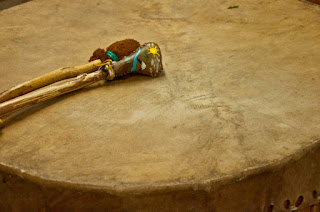The drum, often called the shaman's horse, provides the shamanic practitioner a relatively easy means of controlled transcendence. Researchers have found that if a drum beat frequency of around three to four beats per second is sustained for at least 15 minutes, it will induce significant trance states in most people, even on their first attempt. The drum becomes the practitioner's mount, and the drumstick becomes a riding crop. Riding the rhythm of the drum at the speed of sound, the practitioner journeys to the inner planes of consciousness and back.
Through the sound of the drum, which is customarily made of wood from the World Tree (axis mundi), the practitioner is transported to the cosmic axis (spinal column) within and conveyed from plane to plane. As noted Tuvan Siberian ethnomusicologist Valentina Suzukei explains: "There is a bridge on these sound waves so you can go from one world to another. In the sound world, a tunnel opens through which we can pass, or the shaman's spirits come to us. When you stop playing the drum, the bridge disappears."(1)
The shamanic horse, namely the single-headed frame drum, originated in Siberia, along with shamanism itself thousands of years ago. Shamanic drumming is considered one of the oldest methods for healing and accessing inner wisdom. Practiced in diverse cultures around the planet, this drum method is strikingly similar the world over. Shamanic drumming uses a repetitive rhythm that begins slowly and then gradually builds in intensity to a tempo of three to seven beats per second. The ascending tempo will induce light to deep trance states. Practitioners may progress through a series of trance states until they reach the level that is necessary for healing to occur.
Basically, shamanic drumming is a technique of accessing and directing archetypal or transpersonal powers for healing and manifesting what is needed to benefit the community. It is a simple and effortless way to still the incessant chatter of the mind, thereby inducing a shamanic trance state. Shamanic drumming carries awareness into the transcendent realm of the collective unconscious, the infinite creative matrix of all that we are, have been and will ever be. It is an inward spiritual journey of ecstasy in which one interacts with the inner world, thereby influencing the outer world.
During shamanic flight, the sound of the drum serves as a guidance system indicating where the journeyer is at any moment or where they might need to go. The drumbeat also serves as an anchor or lifeline that the traveler follows to return to their body when the trance work is complete. One of the paradoxes of rhythm is that it has both the capacity to move your awareness out of your body into realms beyond time and space, and to ground you firmly in the present moment. It allows you to maintain a portion of ordinary awareness while experiencing nonordinary awareness. This allows recall or recollection of the visionary experience. When ready to exit the trance state, the practitioner simply slows the tempo of drumming, drawing consciousness back to normal. Shamanic drumming continues to offer today what it has offered for millennia -- a simple and effective technique of ecstasy.
Although sounding simple and redundant, the unique connection between the drum and the practitioner gives this drumming great power, richness and depth. According to Valentina Suzukei, "shamanic drumming is not monotonous at all. Constant changes in timbre and volume keep them interesting...If you don’t listen for timbre, but only for pitch and rhythm the music is boring, monotonous. But the player's every smallest change of mood is reflected in timbre."(2)
It is the subtle variations in timbre and ever-changing overtones of the drum that allow the shamanic practitioner to communicate with the spiritual realm. Drumming opens one's inner, spiritual ears and eyes and also calls the helping spirits. By changing and listening to the tones, pitches and harmonics of the drum, the practitioner is able to send messages to and receive them from the spirit world.
The Shaman's Steed
The role of the horse in Siberian shamanism is predominately that of an animal that transports a shaman in his journeys, especially his journeys to the World Tree. In the shamanic traditions of East, Central and North Asia, winged horses symbolize the shaman's soul or the shaman's steed carrying the rider to Heaven. Among the Yakut people of Siberia, the drum was symbolically called kulan-at or "wild horse." The drum was the very heart of the shaman's steed. The Buryat, a Mongolic ethnic group native to southeastern Siberia, make their drums out of horse skins. The Buryat see the stars as a herd of horses tethered to the World Tree, which is represented by the pole star.
Throughout Mongolia, the drum is called Omisi Murin, which translates as Spirit Horse. The repetitive, rhythmic cadence of shamanic drumming is evocative of a horse on a journey. Mongolian and Siberian shamans describe it as the blissful, transcendent state that one mounts and rides from plane to plane. As Siberian shaman Tania Kobezhikova puts it, "My drum can connect me to the earth or carry me like a flying horse."(3) We can ride Spirit Horse on journeys through the inner realms of consciousness. As a form of transport for the body and the soul, Spirit Horse will let you ride him and will take you where you want to go. Do you need to get somewhere physical or spiritual? Spirit Horse will assist you and serve as your guardian spirit, giving safety in your physical and metaphysical journeys.
1. Kira Van Deusen, "Shamanism and Music in Tuva and Khakassia," Shaman's Drum, No. 47, Winter 1997, p. 24.
2. Kira Van Deusen, Singing Story, Healing Drum: Shamans and Storytellers of Turkic Siberia (McGill-Queen's Press, 2005), p. 124.
3. Van Deusen, Singing Story, Healing Drum, p. 122.

















